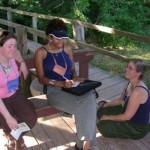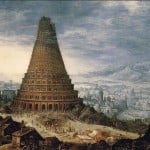Wallace Stevens once said, “How full of trifles everything is! It is only one’s thoughts that fill a room with something more than furniture.” At first glance, this perhaps sounds like a Disneyesque reflection on the uses of a hearty imaginal life. Or—since Stevens was a poet—a reflection on the power of metaphor to set solid things flying.
At second glance—since Stevens was both a poet and an atheist—perhaps it is a reflection on what he saw as the most fruitful power in the universe—the human mind’s power to construct meaning as we go along in an otherwise material and un-human universe.
Most likely, Stevens meant all these things and more. After all, his poems sport beautiful and improbable and impermanent “furniture” such as peacocks, round jars in Tennessee, and Emperors of Ice-Cream. Stevens also wrote of “the palm at the end of the mind.” Yes, the palm is a tropical tree. It is also the human hand, our hands. We ourselves are the end of meaning . . . because we are the only creatures in the world that reach for something called meaning, at least something called “human meaning.”
Moment to moment we are faced with a question: How do I make sense of my life? “It is only one’s thoughts that fill a room,” Stevens wrote, “with something more than furniture.” And it is only one’s thoughts that fill a universe full of furniture with meaning.
Religions (and the lack thereof) reflect the values of the cultures in which they develop. Religions (and their lack) serve as both a reflection of the aspirations of particular groups and also as guides for individuals within a group when we may be in doubt concerning what our culture and our religious belief or non-belief requires of us. They also fill the room with more than furniture. They help us make sense of our lives.
Pragmatist philosophers claim that labeling one “truth” as “false” and another as “true” doesn’t reveal much. It is more useful to see all views—religious and otherwise—as devices to get results. After all, if beliefs did not get results, they would not survive the test of time. The question—at least for those who are free enough of theocracy to have a choice—is which of the many ways of seeing produce the most desirable results,which make the most sense our of life.
Is it somehow useful for making sense of life, for instance, to believe that Fridays which fall on the 13th of the month have special properties?
Over time human beings have posited two very different views of how the world works. One view is that the order we see is the order that is: sure, we will keep discovering more and more about that order, but it’s all out there to observe, albeit some of it observable only with a large hadron collider.
The opposite view (the opposite “truth”) is that there is a higher order not discoverable by observation. This is usually accompanied by speculation concerning a god or gods, though it doesn’t have to. (For example, the Renaissance-era belief in alchemy did not require gods in order to function, even though that belief system existed in parallel to Christianity. )
These polar opposites are not always opposite in practice. Many otherwise “materialist” people leave room for “powers unseen,” as the Book of Common Prayer would have it. Be that as it may, there is a great gulf fixed between those who trust observation to reveal “truth” and those who depend up the revelation of sacred texts and seers of various sorts, be they prophets or gurus.
Wallace Stevens was on the side of observation. He found the most reliable way to get results was to posit a lack of meaning (at least human meaning) beyond the human mind.
Is there a difference between the words of Moses and the words of Wallace Stevens? Stevens thought not. Sure, some poets and some poems are better at filling rooms with more than furniture, and large hadron colliders can rewrite all we know about the room and the furniture. Yet, in essence, it’s all about the human imagination. It’s up to us to animate the room with sense and meaning.
We ourselves are the end of (human) meaning . . . because we are the only creatures in the world that reach for something called (human) meaning. Moment to moment we are faced with a question: How do I make sense of my life? For some of us “truth” is our way of animating the furniture, and we assume our sense is not the sense of another. It is an entertaining place to live.
As Stevens put it,
A gold-feathered bird
Sings in the palm, without human meaning,
Without human feeling, a foreign song.















